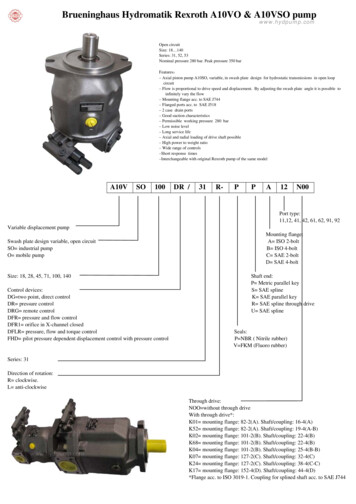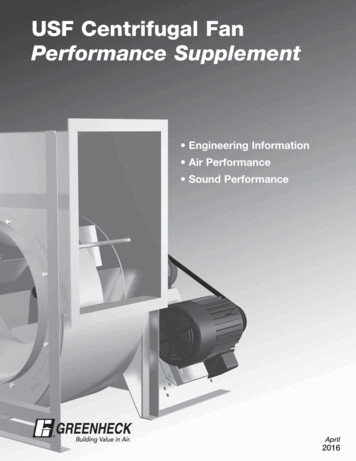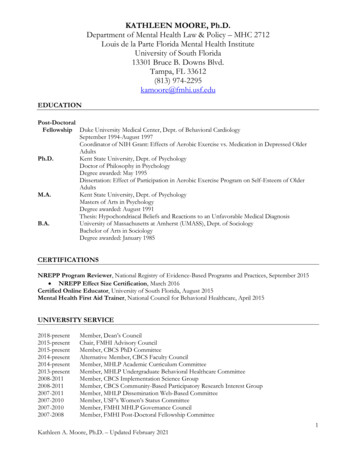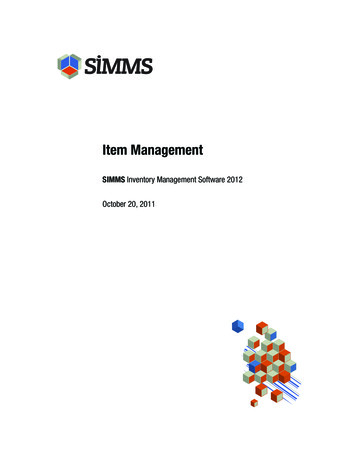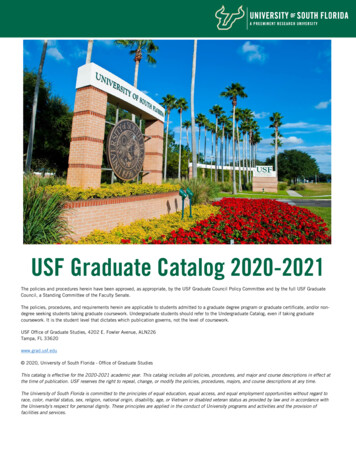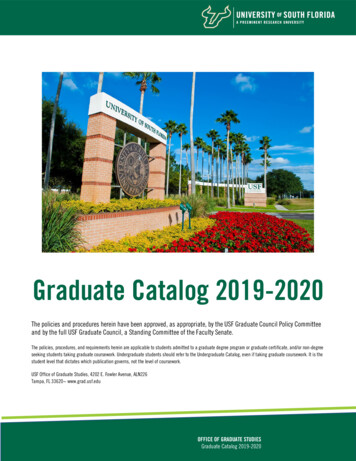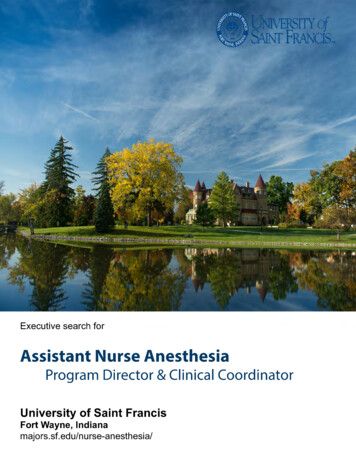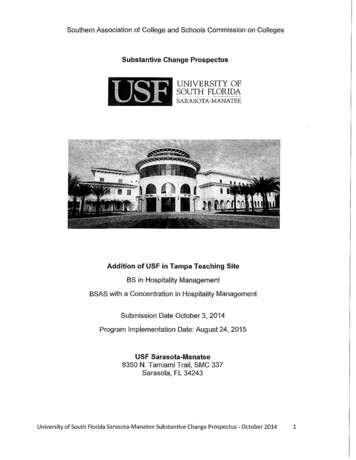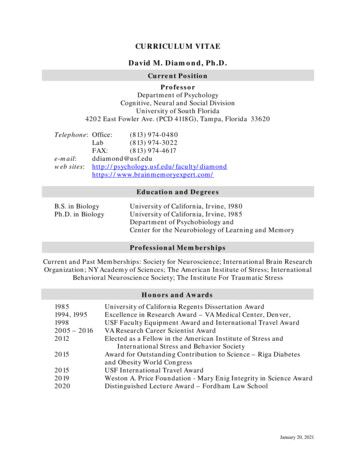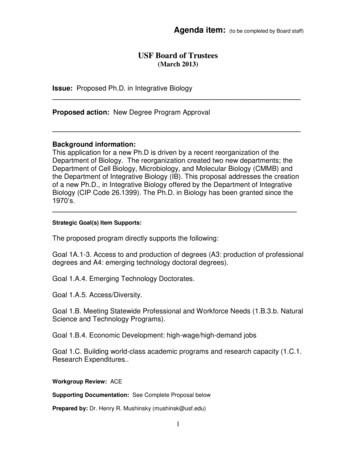
Transcription
Agenda item:(to be completed by Board staff)USF Board of Trustees(March 2013)Issue: Proposed Ph.D. in Integrative BiologyProposed action: New Degree Program ApprovalBackground information:This application for a new Ph.D is driven by a recent reorganization of theDepartment of Biology. The reorganization created two new departments; theDepartment of Cell Biology, Microbiology, and Molecular Biology (CMMB) andthe Department of Integrative Biology (IB). This proposal addresses the creationof a new Ph.D., in Integrative Biology offered by the Department of IntegrativeBiology (CIP Code 26.1399). The Ph.D. in Biology has been granted since the1970’s.Strategic Goal(s) Item Supports:The proposed program directly supports the following:Goal 1A.1-3. Access to and production of degrees (A3: production of professionaldegrees and A4: emerging technology doctoral degrees).Goal 1.A.4. Emerging Technology Doctorates.Goal 1.A.5. Access/Diversity.Goal 1.B. Meeting Statewide Professional and Workforce Needs (1.B.3.b. NaturalScience and Technology Programs).Goal 1.B.4. Economic Development: high-wage/high-demand jobsGoal 1.C. Building world-class academic programs and research capacity (1.C.1.Research Expenditures.Workgroup Review: ACESupporting Documentation: See Complete Proposal belowPrepared by: Dr. Henry R. Mushinsky (mushinsk@usf.edu)1
Board of Governors, State University System of FloridaRequest to Offer a New Degree ProgramUniversity of South FloridaFall 2013University Submitting ProposalProposed Implementation TermIntegrative BiologyArts and SciencesName of College(s) or School(s)Name of Department(s)/ Division(s)Doctor of PhilosophyIntegrative BiologyAcademic Specialty or FieldComplete Name of Degree26.1399Proposed CIP CodeThe submission of this proposal constitutes a commitment by the university that, if theproposal is approved, the necessary financial resources and the criteria for establishing newprograms have been met prior to the initiation of the program.Date Approved by the University Boardof TrusteesPresidentDateSignature of Chair, Board ofTrusteesVice President for AcademicAffairsDateDateProvide headcount (HC) and full-time equivalent (FTE) student estimates of majors for Years 1through 5. HC and FTE estimates should be identical to those in Table 1 in Appendix A.Indicate the program costs for the first and the fifth years of implementation as shown in theappropriate columns in Table 2 in Appendix A. Calculate an Educational and General (E&G)cost per FTE for Years 1 and 5 (Total E&G divided by FTE).ImplementationTimeframeYear 1Year 2Year 3Year 4Year 5ProjectedEnrollment(From Table 1)HCFTE303337404222.524.7527.7530.0031.5Projected Program Costs(From Table 2)E&GCost perFTEE&GFundsContract& GrantsFunds 40,631562,772351,426914,198 29,147562,772351,426914,198AuxiliaryTotal CostFundsNote: This outline and the questions pertaining to each section must be reproduced within the body of theproposal to ensure that all sections have been satisfactorily addressed. Tables 1 through 4 are to be included2
as Appendix A and not reproduced within the body of the proposals because this often causes errors in theautomatic calculations.INTRODUCTIONPreface: This application for a new Ph.D is driven by a recent reorganization ofthe Department of Biology. The reorganization began in 2006 and wascompleted in 2009. The reorganization of the Department of Biology, in part,reflected the enormity of the biological sciences, and in part, different researchperspectives and directions taken by the faculty in each of the respective areasof biology. Part of the reorganization was to replace the original Ph.D. in Biologywith two new doctoral degrees that better serve the needs of the State and ourcurrent graduate students by enabling greater focus of the research performed toearn the Ph.D. The well-established and highly productive faculty attractsstudents to the Tampa Campus from all over the United States as well as fromforeign countries. The resources to support the two Ph.D. programs havealready been established in the Department of Biology and are sufficient tosupport the two new degree programs. The reorganization created two newdepartments; the Department of Cell Biology, Microbiology, and MolecularBiology (CMMB) and the Department of Integrative Biology (IB). This proposaladdresses the creation of a new Ph.D., in Integrative Biology offered by theDepartment of Integrative Biology (CIP Code 26.1399). The name of theDepartment, Integrative Biology, reflects the belief that the study of biologicalprocesses and systems can best be accomplished by the incorporation ofnumerous integrated approaches.I.Program Description and Relationship to System-Level GoalsA. Briefly describe within a few paragraphs the degree program underconsideration, including (a) level; (b) emphases, including concentrations, tracks,or specializations; (c) total number of credit hours; and (d) overall purpose,including examples of employment or education opportunities that may beavailable to program graduates.Level: The proposed degree is the Ph.D. and is a graduate level degree.Emphases, including concentrations, tracks, or specializations: The Ph.D.program in Integrative Biology is built to facilitate research in three Areas ofConcentration including Ecology and Evolution, Morphology and Physiology, andEnvironmental and Ecological Microbiology. These three areas of concentrationalso reflect the integrative nature of the research being conducted by members ofthe Department. Many of the students working within the Ecology and EvolutionArea have interests in conservation biology and develop skills in molecularecology to understand genetic relationships of the organismsthey study. Moststudents in the Ecology and Evolution area also become well-versed inGeographic Information System applications to study past and presentdistributions of the focal species. Students working within the Morphology andPhysiology Area are performing research in functional and comparativemorphology. Students working within the Environmental and EcologicalMicrobiology Area are becoming experts in identifying pollutants that contaminate3
the fresh water systems of Florida and beyond and are developing rapid methodsof identifying the sources of those pollutants or may be studying microbes thatplay a major role in the global carbon cycle. A significant number of our studentsconduct research in areas that are considered “applied biology,” that is, theirresearch is aimed at solving problems that benefit the State of Florida andbeyond.Total number of credit hours: This degree requires 90 semester hours beyondthe Bachelor’s DegreeOverall purpose including examples of employment or educationopportunities that may be available to program graduates: This degree ispart of the broader area of academics known as STEM (Science, Technology,Engineering and Math). The goal of the faculty is to cultivate scientists toadvance our knowledge and understanding of the natural world. Our recentPh.D. students have had great success finding professional positions directlyafter graduation or after gaining additional experience through post doctoraltraining. A few examples of the types of positions taken by recent graduatesinclude; Research Scientist for the U.S. Geological Service in California, PostDoctoral Researcher at Pennsylvania State University, Post Doctoral Researcherat Harvard, faculty member at Allegheny College, faculty member at theUniversity of Tampa, Fisheries Biologist for the State of Washington, and aSenior Ecologist for national biological consulting firm.B. Describe how the proposed program is consistent with the current StateUniversity System (SUS) Strategic Planning Goals. Identify which specific goalsthe program will directly support and which goals the program will indirectlysupport. (See the SUS Strategic Plan at http://www.flbog.org/about/strategicplan/)The proposed program directly supports the following:Goal 1A.1-3. Access to and production of degrees (A3: production of professionaldegrees and A4: emerging technology doctoral degrees). The previousDepartment of Biology became too difuse because of the enormity of the field.The creation of this new degree will prepare students for their professional life inthe 21st Century. The new Ph.D reflects a major emphasis of contemporarybiology, that is, complex questions require multifaceted (integrated) approachesto properly address them. Research within the Department of Integrative Biologyextends from molecular biology to ecosystems analysis. Our students are trainedto meet the challenges of the upcoming decades.Goal 1.A.4. Emerging Technology Doctorates. Faculty within the Department ofIntegrative Biology are involved in numerous areas of science recognized to beon the cutting edge. Recent hires include individuals who conduct research inthe “Ecology of Infectious Diseases,” participate in the new USF “School ofGlobal Sustainability,” are leaders in two new fields of ecology called“Ecoimmunology,” and “Ecotoxicology.” They use molecular techniques as well4
as modern ecological tools to assess an organism’s response to ecosystemfunctions. The newest faculty member studies ecological genetics andgenomics. Graduate students and Post-Doctoral Scholars from across the worldare attracted to work with these new faculty members as well as faculty whoconduct research in the more applied areas of biology, such as “ConservationBiology.”Goal 1.A.5. Access/Diversity. In general minorities are underrepresented in all ofthe sciences. The Department of Integrative Biology currently has Hispanic, andNative American students enrolled in graduate degree programs. Females,which traditionally have been underrepresented in the sciences, are, in fact, inthe majority in our graduate program.Goal 1.B. Meeting Statewide Professional and Workforce Needs (1.B.3.b. NaturalScience and Technology Programs). Graduates with the Ph.D. in IntegrativeBiology will have the training and skills needed to advance the natural sciencesin Florida by contributing to educational programs at the college or universitylevel and by taking employment in biological consulting firms or by participating inlocal, regional or State government agencies.Goal 1.B.4. Economic Development: high-wage/high-demand jobs. Individualswith a Ph.D. in Integrative Biology can expect to earn greater than 65,000 peryear as a starting salary and those who go into industry or consulting can doublethat amount with a few years of experience. According to the latest data availablefrom the Bureau of Labor Statistics, median annual wage of microbiologists was 71,720 in May 2011. The middle 50 percent earned between 48,330 and 87,040. The lowest 10 percent earned less than 38,240, and the highest 10percent earned more than 111,300. Median annual wage of zoologists andwildlife biologists was 61,880 in May 2011. The middle 50 percent earnedbetween 48,060 and 74,500. The lowest 10 percent earned less than 35,550,and the highest 10 percent earned more than 95,850.Goal 1.C. Building world-class academic programs and research capacity (1.C.1.Research Expenditures. A close inspection of the credentials of the faculty wouldindicate that during the past five years they have produced more than 225research papers and attracted about sixteen million dollars in grant funding.In addition to matching the BOG goals, the Department of Integrative Biology isfully aligned with USF’s strategic plan. The proposed Ph.D. program based onthe strengths detailed above directly supports two out of four University strategicgoals. These are:1. Expanding world-class interdisciplinary research, creative, andscholarly endeavors2. Promoting globally competitive graduate programs that supportinterdisciplinary inquiry, intellectual development, knowledge andskill acquisition, and student success through a diverse, fullyengaged, learner-centered campus environment.5
C. If the program is to be included in an Area of Programmatic Strategic Emphasisas described in the SUS Strategic Plan, please indicate the category and thejustification for inclusion.The Areas of Programmatic Strategic Emphasis:1. Critical Needs: Education Health Professions Security and Emergency Services2. Economic Development: Globalization Regional Workforce Demand3. Science, Technology, Engineering, and Math (STEM)This degree is categorized as a STEM Program that is dedicated to the trainingthe next generation of professional biologists. The breadth of the programextends from studies at the molecular level focused on newly discovered patternsof inheritance (epigenetics) to organismal responses to global warming.Research into the biology of infectious diseases is an active area of study.This degree also contributes to the critical need in Education because many ofour graduates become faculty members at colleges and universities worldwide.We have placed many graduates in teaching and/or research positions, some atResearch 1 universities after several years of postdoctoral training.D. Identify any established or planned educational sites at which the program isexpected to be offered and indicate whether it will be offered only at sites otherthan the main campus.This degree is offered only on the Tampa Campus; it requires extensivelaboratory equipment and/or extensive equipment for field research projects thatare not available elsewhere in the USF System.INSTITUTIONAL AND STATE LEVEL ACCOUNTABILITYII.Need and DemandA. Need: Describe national, state, and/or local data that support the need for morepeople to be prepared in this program at this level. Reference national, state,and/or local plans or reports that support the need for this program and requestsfor the proposed program which have emanated from a perceived need byagencies or industries in your service area. Cite any specific need for researchand service that the program would fulfill.The growing human population in Florida will exert a great strain on our naturalresources, especially the supply of drinking water and the treatment of effluentsfrom industrial and agricultural enterprises. Students in the Environmental andEcological Microbiology concentration are trained to help local and regional stateagencies overcome problems related to water quality. According to the latest6
data from the Bureau of Labor Statistics (http://www.bls.gov/bls/blswage.htm)biological scientists held about 108,000 jobs in 2011, including 17,660microbiologists, 18,380 zoologists and wildlife biologists, and 18,900conservation biologists. In addition, many biological scientists held biology facultypositions in colleges and universities but are not included in these numbers.About 40 percent of all biological scientists are employed by Federal, State, andlocal governments. Federal biological scientists worked mainly for the U.S.Departments of Agriculture, Interior, and Defense and for the National Institutesof Health. Most of the others worked in scientific research and testinglaboratories, the pharmaceutical and medicine manufacturing industry, oreducational institutions. Employment of biological scientists is expected toincrease at a much faster rate for all occupations although there will continue tobe competition for some basic research positions. Employment of biologicalscientists is projected to grow 21% over the 2010—2020 decade, much fasterthan the average for all occupations, as applied research and developmentcontinues to drive job growth. Biological scientists enjoyed very rapidemployment gains over the past few decades—reflecting, in part, the growth ofthe biotechnology industry. Employment growth will moderate somewhat.However, much of the basic biological research done in recent years hasresulted in new knowledge, including the isolation and identification of genes.Biological scientists will be needed to take this knowledge to the next stage,understanding how certain genes function within an entire organism. Applicationsof the knowledge gained through research can have far reaching benefits, forexample by helping farmers increase crop yields by pinpointing genes that canhelp crops, such as wheat, grow in more extreme climate conditions.A growing demand exists for conservation biologists in the State of Florida;individuals trained to understand the biology of rare and endangered species aswe all as those trained to manage invasive exotic species. The Bureau of LaborStatistics reports that employment of conservation biologists is expected to growby 12% during the 2010–2020 decade, about as fast as the average for alloccupations. A majority of conservation scientists are employed by Federal,State, and local governments, and a large percentage of new jobs will be foundin these areas. In recent years, the prevention and mitigation of wildfires hasbecome the primary concern for government agencies managing forests andrangelands. The development of previously unused lands, in addition to changingweather conditions, has contributed to increasingly devastating and costly fires.Increases in funding and new programs will create new opportunities forecologists and conservation biologists. Workers will be needed to manage landsin order to minimize the risk of fires and mitigate their impact. Conservationbiologists manage the use and development of forests, rangelands, and othernatural resources. Conservation biologists often specialize in one of severalareas, such as soil conservation, urban ecology, habitat restoration, native rareand threatened species, or forest ecology.On 17 September 2012, the website l listed a total of 245 Wildlife biology positions and 524 BiologicalScience jobs in Florida. Not all of these job vacancies required a Ph.D. for theposition, but many require graduate degrees and the highest paying jobs require7
the Ph.D.B. Demand: Describe data that support the assumption that students will enroll inthe proposed program. Include descriptions of surveys or other communicationswith prospective students.The faculty members who now comprise the Department of Integrative Biologyhave a particularly strong track record of attracting highly qualified students fromall parts of the globe to work in their research laboratories. The Department hashad a long standing policy that no students are accepted into the programwithout a faculty sponsor who is willing to mentor the student from the day he/sheenters the campus. We have had students from 23 countries and 30 states applyfor admission into the Department of Integrative Biology in the past five years. Insum, we have received applications from 229 students interested in pursuinggraduate degrees; we admitted 83 of them (36%) and 62 (75%) of those admittedenrolled in our program during the past five years.C. If substantially similar programs (generally at the four-digit CIP Code or 60percent similar in core courses), either private or public exist in the state, identifythe institution(s) and geographic location(s). Summarize the outcome(s) ofcommunication with such programs with regard to the potential impact on theirenrollment and opportunities for possible collaboration (instruction andresearch). In Appendix B, provide data that support the need for an additionalprogram as well as letters of support, or letters of concern, from the provosts ofother state universities with substantially similar programs.Biology doctoral programs exist at the University of Florida, Florida StateUniversity, University of Central Florida, Florida International University, and theUniversity of Miami. None of these programs have the 26.1399 CIP codeshowever. Nevertheless the other programs in the State have co-existed with thecurrent University of South Florida Ph.D. program for decades. The change willhave no negative effects on the undergraduate program which is co-administeredand delivered currently by the faculty of the two biology departments (IntegrativeBiology and Cell biology, Microbiology and Molecular Biology) The focusing ofthe graduate programs may well create further opportunities for collaboration.Use Table 1 in Appendix A (A for undergraduate and B for graduate) to categorize projectedstudent headcount (HC) and Full Time Equivalents (FTE) according to primary sources.Generally undergraduate FTE will be calculated as 40 credit hours per year and graduate FTEwill be calculated as 32 credit hours per year. Describe the rationale underlying enrollmentprojections. If, initially, students within the institution are expected to change majors to enroll inthe proposed program, describe the shifts from disciplines that will likely occur.8
9
III.BudgetA. Use Table 2 in Appendix A to display projected costs and associated fundingsources for Year 1 and Year 5 of program operation. Use Table 3 in Appendix A toshow how existing Education & General funds will be shifted to support the newprogram in Year 1. In narrative form, summarize the contents of both tables,identifying the source of both current and new resources to be devoted to theproposed program. (Data for Year 1 and Year 5 reflect snapshots in time ratherthan cumulative costs.) If the university intends to operate the program throughcontinuing education on a cost-recovery basis or market rate, provide a rationalefor doing so and a timeline for seeking Board of Governors’ approval, ifappropriate.Table 2 is a summary of the costs for the proposed program. Because we areproposing a name change for an existing program rather than the creation of anew Ph.D. no new resources will be required for this program. The impetus forthe change in the Ph.D. was the reorganization of the Department of Biology intotwo new departments. The Ph.D. in Integrative Biology and the three new Areasof Concentration that have been developed within this program allow students tofocus their research on high demand topics. Because the number of Ph.D.students in the department is near capacity for the number of faculty, we don’texpect any significant changes in the student population in the near future anddon’t anticipate the need for any increase in funding. Current students will havethe opportunity to switch to the new degree or stay with the current degree whichwill be phased out when the current students graduate.B. If other programs will be impacted by a reallocation of resources for the proposedprogram, identify the program and provide a justification for reallocatingresources.Specifically address the potential negative impacts thatimplementation of the proposed program will have on related undergraduateprograms (i.e., shift in faculty effort, reallocation of instructional resources,reduced enrollment rates, greater use of adjunct faculty and teaching assistants).Explain what steps will be taken to mitigate any such impacts. Also, discuss thepotential positive impacts that the proposed program might have on relatedundergraduate programs (i.e., increased undergraduate research opportunities,improved quality of instruction associated with cutting-edge research, improvedlabs and library resources).As the proposed program has been in existence for several decades in theformer Department of Biology, we don’t anticipate any negative effects of the newPh.D. program on any other departments or programs. The faculty that nowcomposes the Department of Integrative Biology has a long history of engagingundergraduate students in research and shall continue to do so. The USF libraryprovides complete access to the electronic journals needed to support the newPh.D. program and an up to date collection of books and other resources.C. Describe other potential impacts on related programs or departments (e.g.,increased need for general education or common prerequisite courses, orincreased need for required or elective courses outside of the proposed major).The Department of Integrative Biology and the Department of Cell Biology,10
Molecular Biology and Microbiology offer undergraduate and graduate coursesthat can be taken by students housed in either of the two new departments. Thecourses are existing courses and the proposed new Ph.D. in Integrative Biologydoes not require the creation of any new courses beyond those that already existand are taught on a regular basis.D. Describe what steps have been taken to obtain information regarding resources(financial and in-kind) available outside the institution (businesses, industrialorganizations, governmental entities, etc.). Describe the external resources thatappear to be available to support the proposed program.During the past five years the faculty members in the Department of IntegrativeBiology have attracted more than 16,000,000 in extramural funding. Outsidefunding sources and the total dollar value obtained from those sources are listedbelow.A.D. Levine, Civil & Environmental Engineering. 43,792Cemex 750,000Curtis Charitable Trust 200,000Department of Military and Veteran Affairs, 157,533Disney Wildlife Conservation Fund 119,680DSM Dyneema B.V., 3,500.Georgia Aquarium and Mote Marine Laboratory, 9,300.Environmental Protection Commission of Hillsborough County. 226,962.EPA STAR program, 135,276Florida Center for Solid and Hazardous Waste Management. 10,000Florida Department of Agriculture, 38,925Florida Department of Environmental Protection 1,470,758Florida Department of Health. 227,181Florida Fish and Wildlife Conservation Commission, 109,000Florida Institute of Oceanography, 8,000.00.Institute for the Study of Latin America and the Caribbean 5,700.Jacksonville Electrical Authority. 46,240.National Evolutionary Synthesis Center 36,000National Science Foundation. 8,291,276National Park Service, 89,996National Sea Grant. 40,000.11
New York Sea Grant 55,151.National Institute for Global Environmental Change 348,000NOAA-CICEET 68,974NOAA, 674,585Pasco County Stormwater. 70,200Pinellas County Environmental Foundation 26,650Sarasota County, FL. 14,000.Scott’s Company, 2,000, 10,000St. Johns River Water Management District. 80,000USDA. 398,500.St. Lucie County, Florida. 84,655.Southwest Florida Water Management District. 250,277Tampa Bay Estuary Program. 94,561.The Conservancy of Southwest Florida. 196,018US Environmental Protection Agency . 1,043,353US Fish and Wildlife Service, 175,010USF GAP Program. 10,000USF Division of Sponsored Research, 15,250USF New Researcher Grant. 8,735USF Honors College, 5,000U.S. Dept. of Interior, 145,000,US Department of Agriculture 519,538University of Florida IFAS Research Innovation Grants 50,000University of Miami. 71,069.IV.Projected Benefit of the Program to the University, Local Community, and StateUse information from Tables 1 and 2 in Appendix A, and the supporting narrative for“Need and Demand” to prepare a concise statement that describes the projectedbenefit to the university, local community, and the state if the program isimplemented. The projected benefits can be both quantitative and qualitative innature, but there needs to be a clear distinction made between the two in the narrative.12
Benefit to the University: Very High Research Universities, such as USF, existwith a strong complement of science departments and the Department ofIntegrative Biology is an integral part of our strong science programs. The wellestablished Ph.D. program in integrative biology will attract 30-42 new, highlyqualified and talented students to USF. Our outstanding record of excellence inresearch attracts post-doctoral researches to our campus as well. Another directbenefit to the University of having a strong Ph.D. program in Integrative Biologyis the high quality graduate students who serve as teaching assistants in thelaboratories for undergraduate courses. Virtually every graduate student in theDepartment gets some teaching experience. Because the Department attractsvery high quality students, the undergraduates benefit from their knowledge andtheir dedication to quality instruction.Benefit to the Community: Faculty and graduate students interact with manyagencies in Florida, including South West Florida Water Management District,Brooker Creek Preserve, Walt Disney World, Mote Marine Institute, Lowry ParkZoological Gardens, Florida Forestry Agency, and numerous surroundingcounties just to mention a few examples. We provide expert opinion on landmanagement practices, and facilitate cooperative research projects.Benefit to Florida: Faculty and graduate students interact with the Florida Fishand Wildlife Commission, the Florida Parks Association, Florida Department ofHealth, Florida Institute of Oceanography, Florida Department of EnvironmentalProtection, Florida Center for Solid and Hazardous Waste Management, just tomention a few examples. We provide expert opinion and planned researchprojects to help these agencies carry out their missions.The Ph.D. in Integrative Biology supports the current State University SystemStrategic Planning Goal 1A.1-3. Access to and production of degrees, Goal1.A.4. Emerging Technology Doctorates, Goal 1.A.5. Access/Diversity, Goal 1.B.Meeting Statewide Professional and Workforce Needs, Goal 1.B.4. EconomicDevelopment: high-wage/high-demand jobs, Goal 1.C. Building World-classAcademic Programs and Research Capacity.V.Access and Articulation – Bachelor’s Degrees OnlyA. If the total number of credit hours to earn a degree exceeds 120, provide ajustification for an exception to the policy of a 120 maximum and submit aseparate request to the Board of Governors for an exception along withnotification of the program’s approval. (See criteria in Board of GovernorsRegulation 6C-8.014)Insert response here.B. List program prerequisites and provide assurance that they are the same as theapproved common prerequisites for other such degree programs within the SUS(see the Common Prerequisite Manual at FACTS.org). The courses in theCommon Prerequisite Counseling
Biology (CMMB) and the Department of Integrative Biology (IB). This proposal addresses the creation of a new Ph.D., in Integrative Biology offered by the Department of Integrative Biology (CIP Code 26.1399). The name of the Department, Integrative Biology, reflects the belief that the study of biological
